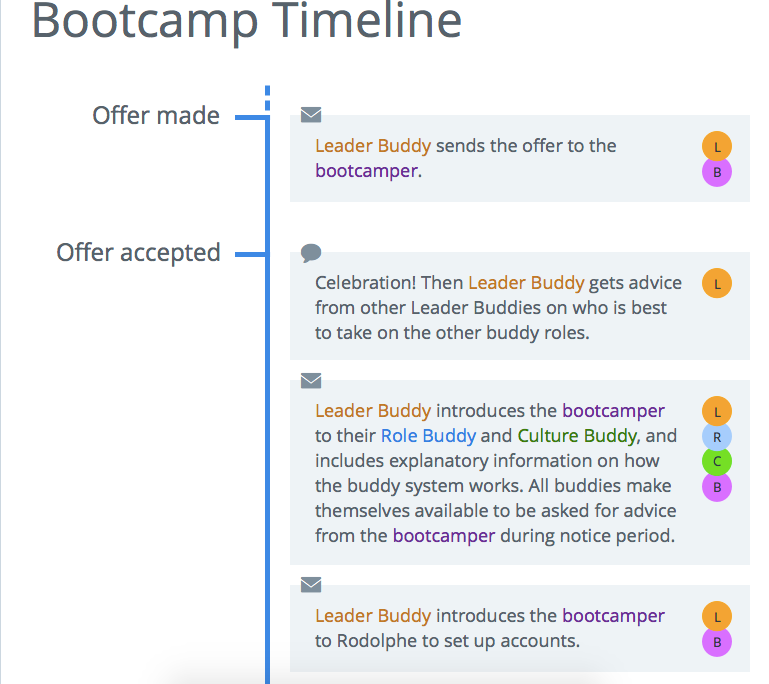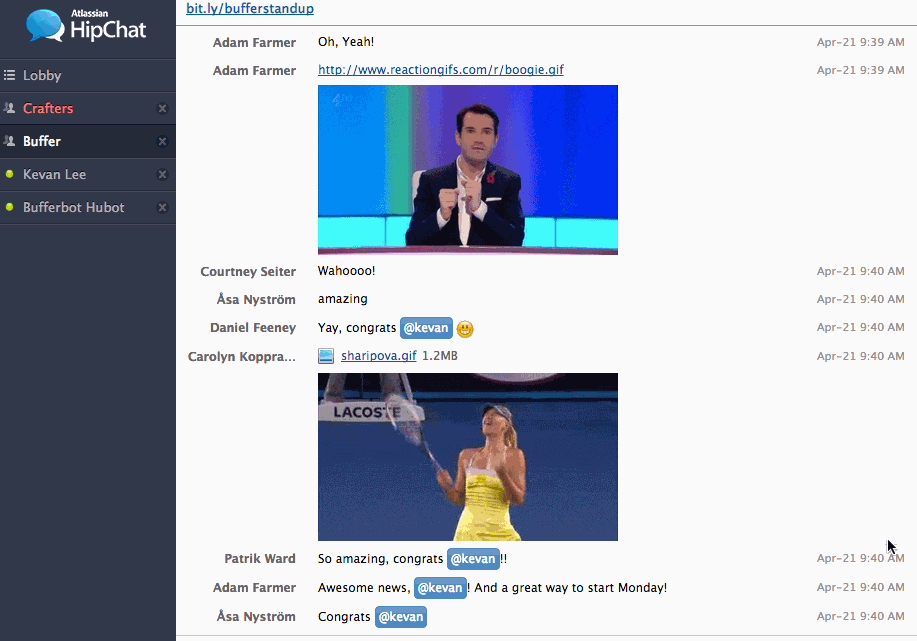Heads up! This is an older post and we’ve since retired the Buffer bootcamp. Feel free to see the latest information here, including all the reasons why we made this change!
We’re Retiring The ‘Buffer Bootcamp’ Period For New Teammates – Here’s Why

Some call it a trial. Some call it a probationary period. We call it the Buffer Bootcamp.
Our intro period for new hires is something we often reference in our monthly updates and hiring reports, but we’ve yet to really take you inside how this process works. Well, we’re happy to change that! We’d love to invite you in to see how these first 45 days for new employees look and to explain what we hope to achieve during bootcamp.
I recently completed my Buffer Bootcamp, and I’ll be your guide, taking you inside my experience and how the bootcamp works.
The Buffer Bootcamp overview
Put simply: Bootcamp is our opportunity to ensure that the new hire and the company are a perfect fit with one another.
The name is a clever take on the traditional probationary period, and it’s far from a bootcamp in the traditional sense—there are no pushups, buzz cuts, or army fatigues here, promise. It’s simply an immersion into the way that Buffer works and a chance for everyone involved to find out if the fit is perfect.
Here are the bootcamp basics.
- Buffer Bootcamp is a 45-day period. We count weekends in here, so bootcamp typically ends after six weeks.
- During these six weeks, the new hire has a one-on-one chat every two weeks with either a team lead or our CEO Joel to discuss how things are going.
- In terms of pay, new hires are contract employees for the first six weeks and then become full-time, salaried employes if hired on.
- No healthcare benefits, equity, or retreats just yet.
- New hires do get a Kindle Paperwhite and Jawbone UP right away so they can dive into the Buffer culture.
- Bootcampers get 3 “buddies” to help them along their journey: A Leader Buddy, a Role Buddy and a Culture Buddy.
Here’s how Joel and Leo describe Buffer bootcamp:
Bootcamp gets brought up at every stage of the interview process so that applicants know in advance how things work when they start at Buffer. The goal is to be as transparent as possible about the onboarding process and the expectations for new hires.
Any and all questions are welcome. I know for me, coming from a traditional office setup, bootcamp was radical, exciting, nerve-wracking, and fascinating. Like many new hires (and maybe you, too), I had lots of questions. Here are a handful that get asked most often.
What’s it like to join Buffer without a guaranteed, full-time position?
There’s definitely an element of risk with signing on for bootcamp, especially for those of us who left other jobs to join Buffer. You’re likely to hear new hires say they are “jumping in head first” (or feet first, depending on how they jump).
I jumped head first. Before joining Buffer, I spent six years in the marketing department for an international health company, and I appreciated a lot of the safety I felt there: steady income, job security, seniority, etc. Signing up for Buffer Bootcamp was a thrilling moment for me—and more than a little nerve-wracking. Maybe everyone feels this way when changing jobs? Maybe those of us with families weigh these decisions a little more heavily?
Fortunately, there are a number of reassuring moments along the way. Right off the bat, the “Welcome to Buffer” email from your team lead goes a long way toward building you up and reminding you about the purpose and intent behind bootcamp. Here’s an excerpt from the email I received:
To start, you should know that we think you’re awesome, inspirational, and smart. (That’s why we chose you to bring on board, out of many applications.) We are super, super excited to have you on board with us! We wouldn’t have chosen you if we thought that you didn’t have exactly what it takes to kick ass at Buffer. So, Buffer Bootcamp is a short amount of time for us to get to know you, you to get to know us, and give you a really honest taste of what it’s like to work for Buffer. (We hope you’ll love it!)
There are also some healthy perspectives to take when looking at bootcamp. In many ways, bootcamp is similar to a probationary period at any job. With bootcamp, we’re just a bit more intentional about ensuring an ideal fit.
Or if metaphors are more your style, here’s a helpful one we’ve floated around:
Bootcamp is a little like dating.
Both sides are really interested in each other and eager to spend time together and build a relationship. There’s no need to rush off and get engaged right away. It takes time (six weeks, say) to know if you two are a good fit or not.
Most of the time, the fit is great, and after 45 days, the new hire is given an offer to join Buffer full time. Sometimes, of course, it doesn’t work out. Which leads to the next question …
How many people make it through Bootcamp?
Presently, about 70 percent of the new hires become full-time employees after the 45-day bootcamp. We really try to ensure a good fit during the interview process so that we’re bringing on only those who are most aligned with our culture, values, goals, and ideas. It’s inevitable that there will be occasions where the fit isn’t perfect. We hope to minimize these as much as possible with the way we interview.I went through three different interview stages:
- Interview with Leo—introduction to Buffer, about the position
- Interview with Carolyn—mostly about Buffer culture
- Interview with Joel—a good mix of position and culture and Buffer in general
Culture is just as important in these interviews as the position itself.
When those times do come that a Bootcamp period doesn’t end in an offer, the decision can be either that of the company or that of the employee. Buffer wants what’s best for both parties, which is why each side gets a say in how the fit feels.
Again, to borrow from the introductory email:
With such a small team, we find it helpful to make sure that, after the interviews are over and you’re getting your hands dirty, it still feels like a great fit. (We fully expect that it will.) At the end of the 45 days, if either you or Buffer doesn’t feel sure, then we’ll part ways with no hard feelings. This is something that we do take quite seriously, especially with such a small team. We feel it is super important that all new hires are aligned and feel comfortable.
There are many different variables that could affect someone coming on full-time with Buffer. Here are just a few that might have an impact:
- Practicing the values and culture of Buffer
- Ability to keep up with a fast-paced, startup environment
- Quality and consistency of one’s work
- Willingness to accept feedback
It’s perhaps no coincidence that many of these factors—culture, startup, skill—are central to the way we choose candidates to interview. You can see below how these attributes (along with Buffer usage) inform the way we hire.

Throughout bootcamp, the team lead makes a point of communicating how the bootcamp period is progressing for the new hire and if there are any specific ways he or she can improve. This is the impetus for the one-on-one chats every two weeks.
What are the one-on-ones like?
Coaching, feedback, and open communication are highly valued at Buffer, and this begins right from the start during the six weeks of Bootcamp. Here’s the schedule for a person’s one-on-one chats:





The wonderful part about these chats is that the new hire does most of the talking. You are encouraged to share your experiences so far, to celebrate your successes, and to identify areas of improvement. The chats have a two-part focus: work and culture. You have the chance to discuss what you’ve accomplished as well as how you’ve experienced Buffer’s values.
There is, of course, plenty of opportunity for feedback at this stage. The team lead passes along any bits of helpful advice or areas where you may be able to take another step forward. The goal is that you’ll have a clear idea of where you stand, and vice versa. Feedback is encouraged for any areas of improvement that you could see Buffer make as well.
The bootcamp is an entirely two-way street.
My chats were evidence of just how fast things move at Buffer. When I joined up at the first of March, Courtney and I were both content crafters, along with Belle, and we worked with Leo on blog content, social media, and marketing.
When it came time for my two-week chat, everything had changed! Courtney was Head of Content Marketing, Belle was transitioning toward a full-time role at her startup, and Leo was overseeing a huge number of areas in his role as COO.
So my two-week chat was with Courtney, my new team lead. And I found that it’s harder than you think to talk about yourself for an hour. Good thing I brought notes! That first chat turned out to be an incredible moment of encouragement for me, as I felt really validated that I was moving ahead in the right direction.
At four weeks, I chatted with Leo (who happened to be at Buffer retreat in South Africa!). He was great to have so many specific examples of things I was doing well, and we talked at length about culture, productivity, and the challenges of working remotely. I got some great tips about boundaries.
My 45-day chat, I was thrilled to be offered a full-time position on the team! Leo delivered the good news, and we talked at length again about my work and where I’d like to go with Buffer. He asked, “What parts of my job make me happiest?” No one had ever asked me that before!
What’s it like meeting everyone?
Along with the two-week chats, a main task of bootcamp is for the new hire to sync up with everyone on the team at some point during the 45 days. Even with a team of 20, it’s harder than it sounds!

There is a goal behind meeting all these folks, of course, beyond the great introduction. Connecting in a purposeful way trains you to reach out, connect, and socialize with your coworkers well beyond the six-week bootcamp.
Working on a remote team can feel isolating if you let it. Video chat intros are one way to combat this. For me, these syncs are huge because I’m now the sole crafter at Buffer. It’s so helpful to have teammates who are just a click away.
Another way to feel involved is with Buffer’s weekly pair calls. We’d love to write more about these later, so I’ll give just a quick overview: Each week, you are paired with a different teammate, and you sync up daily to talk about what you are working on and what improvements you are hoping to make that week. New hires jump into these pair calls immediately from day one. I was paired with Joel and Leo my first week, and Joel again in my second week. Talk about starting off on a good foot!
(New hires are also encouraged to add a few sentences about personal improvements to Buffer’s weekly improvements hackpad. You can see our most recent one here. )
What do you do with the Kindle and Jawbone?
We have a big focus on reading and self-improvement at Buffer, so it’s great to get new hires plugged in immediately with a Kindle Paperwhite and Jawbone Up. Here’s how we work with each of these awesome tools/toys.
Kindle Paperwhite
Everyone on the Buffer team is encouraged to read as much as possible, so sending each new hire a Kindle and gifting free e-books—on any subject, whenever you want them—is designed to remove all hurdles from reading.
We even have a neat system in place that drops alerts into Hipchat, our 24/7 chatroom office.

You truly are encouraged to read whatever you want; there are no rules about reading job-specific books. Here is a list of the ones I grabbed during my Bootcamp. (You’ll see that they started out job-specific until I got the courage to ask for something else.)
- Advice to Writers by Jon Winokur
- Poke the Box by Seth Godin
- Steal Like an Artist by Austin Kleon
- Raising Cain: Protecting the Emotional Life of Boys by Michael Thompson and Dan Kindlon
- The War of Art by Steven Pressfield
- The Well-Spoken Thesaurus by Tom Heehler
- My Bright Abyss by Christian Wiman
- Football Scouting Methods by Steve Belichick
Jawbone UP fitness band
Many of our weekly improvements involve exercise, movement, or sleep. Since the Jawbone UP tracks all these activities, it has become a really helpful tool to add some quantitative data to our improvements.
Beyond that, our UP bands allow us to track and celebrate the improvements of everyone on the team thanks to our connected accounts inside the app.
We connect with teammates so we can see their progress on sleep, steps, and activities, and we can leave congratulations on their achievements and follow up with goals during pair calls. Let’s say I have goal to sleep eight hours every night and go to bed no later than 10:00 p.m. The UP band tracks all this and makes it accessible to the whole team. Anyone can follow up with me on how I’ve done on my goals.
It’s also an essential tool for those of us with jobs on the computer. You get a great snapshot of how much (or how little) you move each day. It was really interesting to see how my movements split: Great on the weekends, poor on weekdays. The UP band inspired me to hop on my bike and ride to a new work spot more than once during bootcamp.
What happens when you’re done?
For starters, we have a big GIF party in HipChat!

First things first, though, at the 45-day chat with your team lead, you may be given a full-time offer to come work at Buffer. Again, this is all about the perfect fit for you and the company. It is an offer, and you get to choose whether you want to accept it. (My answer was yes, right away!)
At that point, you become Buffer’s newest full-time employee. And we celebrate!

Full-time employees receive a number of additional benefits.
- Attend retreats
- Choose between a salary bump or additional stock options
- Join Buffer healthcare (if you choose)
- Grab whatever equipment will make you happier and more productive (e.g., MacBook Air)
- Get added to the team page
(Funny timing for me, I just missed the cut for joining the team on retreat to South Africa. My bootcamp ended four days after retreat ended. Funny timing for Buffer’s Dan Farrelly, too. He accepted his full-time offer one day before retreat and hopped right on a plane to Cape Town!)
In addition, your two-week chats become mastermind sessions with your team leads and are held every two weeks. These have a slightly different format than the other chats, something we’ve outlined in detail here.
That’s it!Bootcamp is an incredible experience in learning how Buffer works and how it feels to be part of a fast-paced, value-focused company. The perfect fit truly does work both ways. Bootcamp is about you seeing what it’s like to be at Buffer and Buffer seeing what it’s like to have you involved.
If you’re interested in joining our growing team and experiencing this bootcamp for yourself, it’d be awesome to have you browse our job openings. We’re looking for 11 or more new bootcampers!
Any questions about how bootcamp works? I’d love to continue the conversation in the comments. Let me know any thoughts you have, and I’ll be more than happy to chat!
Image credit: Gwen<3you
Try Buffer for free
180,000+ creators, small businesses, and marketers use Buffer to grow their audiences every month.
Related Articles

We've been hosting Retreats at Buffer for 12+ years. In this article, we've detailed everything we've learned from 14 Retreats.

I recently attended my first in-person, international conference. Here's what I learned.

What it was like to join a fully remote team like Buffer, and how going on the company retreat so early on helped shape my journey in ways I hadn’t imagined.
